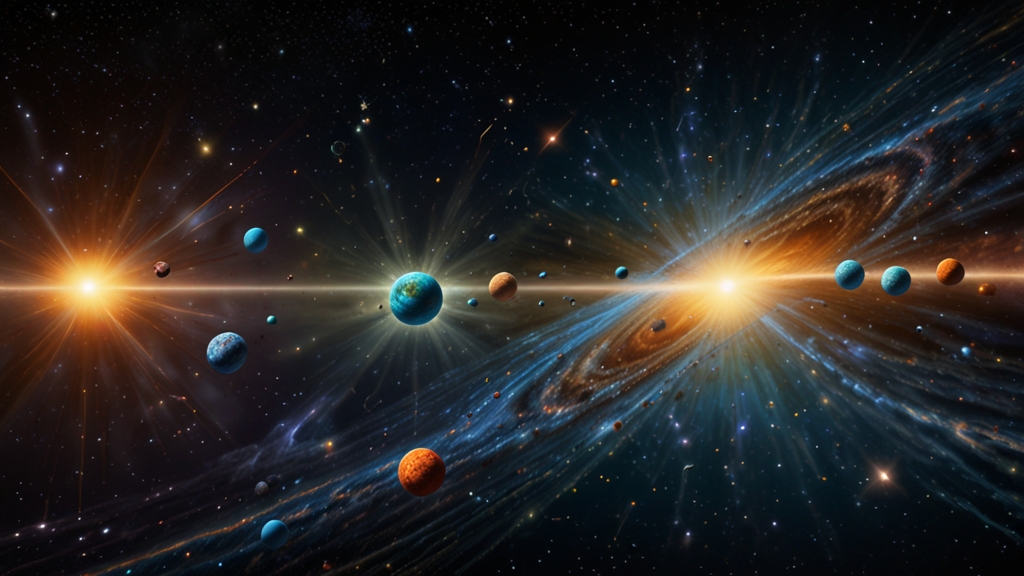From Atoms to Galaxies: The Physics of Everything
The realm of physics attempts to unravel the mysteries of the universe, spanning from the minuscule subatomic particles within atoms to the vast galactic expanses. This field, often termed the 'Physics of Everything,' seeks to provide a comprehensive description of the natural world by relying on mathematical principles and experimental evidence.
The Microcosm: Quantum Mechanics
At the heart of the smallest scales, quantum mechanics reigns supreme. This branch of physics deals with phenomena at the atomic and subatomic levels, where particles such as electrons, protons, and neutrons exhibit behaviors that defy classical physics. The principles of quantum mechanics are encapsulated in the wave-particle duality, the uncertainty principle, and superposition.
"If you think you understand quantum mechanics, you don't understand quantum mechanics." — Richard Feynman
Quantum mechanics introduces a probabilistic nature to the behavior of particles, where outcomes can only be predicted in terms of probabilities rather than certainties. This probabilistic framework has given rise to quantum computing and other technologies, potentially revolutionizing fields from cryptography to material science.
The Macroscale: General Relativity
On a larger scale, Einstein's theory of general relativity provides a framework for understanding gravitational phenomena. This theory posits that massive objects cause a curvature in spacetime, which manifests as gravity. Notably, general relativity has been confirmed through numerous observations, such as the bending of light around stars and the recent detection of gravitational waves.
"Time and space and gravitation have no separate existence from matter." — Albert Einstein
General relativity describes the universe on a cosmological scale, from the orbits of planets to the dynamics of galaxies. It also predicts the existence of exotic objects like black holes, where spacetime curvature becomes so extreme that not even light can escape.
The Intermediate Scale: Classical Mechanics
Between the quantum realm and cosmological structures lies the domain of classical mechanics, which governs the motion of objects we encounter in everyday life. Rooted in the work of Newton, classical mechanics describes how forces interact with masses to produce accelerations. This body of knowledge lays the groundwork for much of engineering, architecture, and astronomy.
While classical mechanics cannot explain phenomena on the quantum or relativistic scales, it remains an indispensable tool for solving a myriad of practical problems. From predicting planetary orbits to designing stable structures, the principles of classical mechanics facilitate a deeper understanding of the physical world around us.
Unifying Theories: The Quest for a Theory of Everything
The ultimate goal in physics is to formulate a 'Theory of Everything' (TOE) that unifies all fundamental forces and particles into a single, cohesive framework. The Standard Model of particle physics successfully unifies three of the four fundamental forces—electromagnetic, weak, and strong interactions—but gravity remains conspicuously absent from this model.
Efforts such as string theory and loop quantum gravity aim to bridge this gap, proposing that the fundamental constituents of the universe are not particles but rather one-dimensional 'strings' or quantized loops of spacetime. Although these ideas are not yet empirically verified, they represent promising pathways toward a unified theory.
Conclusion: The Infinite Journey
The physics of everything, from the subatomic particles in our bodies to the colossal galaxies in the cosmos, continues to be an awe-inspiring field. Every discovery opens a new window into the complexities of nature, challenging our understanding and pushing the boundaries of knowledge.
As we peel back the layers of the universe, we find an intricate tapestry woven by the fundamental forces and particles. While a complete understanding may still be far off, the pursuit of this knowledge is a testament to human curiosity and our never-ending quest to understand the universe's grand design.







